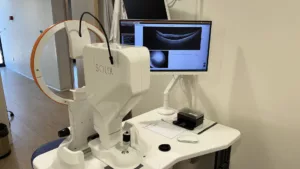Ophthalmological Examination
How often should I visit an ophthalmologist?
A healthy adult aged 18–64 with no eye problems should visit the ophthalmologist every two years. After the age of 65, eye exams should be done annually, as many eye diseases can develop with age. An annual ophthalmological examination helps doctors monitor any changes in vision and maintain overall eye health.
Written by

Diakonis Vasilios MD PhD
Surgeon OphthalmologistDirector, 2nd Ophthalmology Clinic
Metropolitan Hospital

Visual Acuity
During a typical ophthalmological examination, the visual acuity of the patient is measured, which ideally should approach 10/10. In cases where visual acuity is not high without correction, an effort is made to improve it with corrective glasses. If visual acuity cannot be corrected, the ophthalmologist must investigate other potential pathological causes (such as cataract, maculopathy, etc.).

Intraocular Pressure
Next, intraocular pressure is measured, with acceptable normal limits being below 20. In cases where intraocular pressure exceeds 25, patients should undergo glaucoma testing (visual fields, corneal pachymetry).


Clinical Examination
The ophthalmological examination is completed with a clinical check by the ophthalmologist, where the patient’s eyes are examined under magnification using a slit lamp. During this process, the ophthalmologist inspects the anterior structures of the eye (eyelids, conjunctiva, cornea, iris, and crystalline lens), as well as the posterior structures of the eye—fundus examination (retina, macula, and optic nerve). To achieve the fundus examination, patients undergo mydriasis using eye drops (pupil dilation), which may affect their vision for several hours.


Imaging & Functional Examinations
In cases where a pathological finding is observed, the patient undergoes further imaging tests (such as visual fields, OCT, etc.) or functional tests, such as visual field testing.


